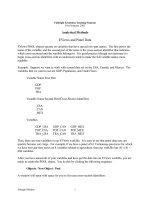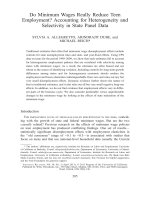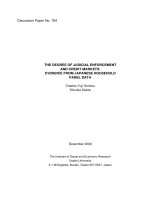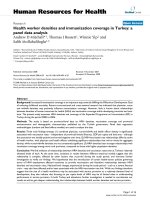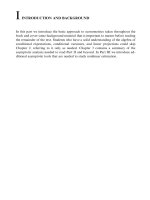Panel Data Econometrics
Bạn đang xem bản rút gọn của tài liệu. Xem và tải ngay bản đầy đủ của tài liệu tại đây (2.39 MB, 399 trang )
PANEL DATA ECONOMETRICS
Theoretical Contributions and Empirical Applications
CONTRIBUTIONS
TO
ECONOMIC ANALYSIS
274
Honorary Editors:
D. W. JORGENSON
J. TINBERGEN†
Editors:
B. BALTAGI
E. SADKA
D. WILDASIN
Amsterdam – Boston – Heidelberg – London – New York – Oxford
Paris – San Diego – San Francisco – Singapore – Sydney – Tokyo
PANEL DATA ECONOMETRICS
Theoretical Contributions and Empirical Applications
Edited by
BADI H. BALTAGI
Department of Economics and Center for Policy Research
Syracuse University, Syracuse, NY 13244-1020
U.S.A.
Amsterdam – Boston – Heidelberg – London – New York – Oxford
Paris – San Diego – San Francisco – Singapore – Sydney – Tokyo
ELSEVIER
The Boulevard, Langford Lane, Kidlington, Oxford OX5 1GB, UK
Radarweg 29, PO Box 211, 1000 AE Amsterdam, The Netherlands
First edition 2006
Copyright © 2006 Elsevier B.V. All rights reserved
No part of this publication may be reproduced, stored in a retrieval system or transmitted
in any form or by any means electronic, mechanical, photocopying, recording or otherwise
without the prior written permission of the publisher
Permissions may be sought directly from Elsevier’s Science & Technology Rights Department in Oxford, UK: phone (+44) (0) 1865 843830; fax (+44) (0) 1865 853333; Email:
Alternatively you can submit your request online by visiting
the Elsevier web site at and selecting: Obtaining
permission to use Elsevier material
Notice
No responsibility is assumed by the publisher for any injury and/or damage to persons
or property as a matter of products liability, negligence or otherwise, or from any use or
operation of any methods, products, instructions or ideas contained in the material herein.
Because of rapid advances in the medical sciences, in particular, independent verification
of diagnoses and drug dosages should be made
British Library Cataloguing in Publication Data
A catalogue record for this book is available from the British Library
ISBN-13: 978-0-444-52172-9
ISBN-10: 0-444-52172-0
For information on all Elsevier publictions
visit our website at books.elsevier.com
Printed and bound in The Netherlands
06 07 08 09 10 10 9 8 7 6 5 4 3 2 1
Introduction to the Series
This series consists of a number of hitherto unpublished studies, which are
introduced by the editors in the belief that they represent fresh contributions to economic science.
The term ‘economic analysis’ as used in the title of the series has been
adopted because it covers both the activities of the theoretical economist
and the research worker.
Although the analytical method used by the various contributors are not
the same, they are nevertheless conditioned by the common origin of their
studies, namely theoretical problems encountered in practical research.
Since for this reason, business cycle research and national accounting,
research work on behalf of economic policy, and problems of planning
are the main sources of the subjects dealt with, they necessarily determine
the manner of approach adopted by the authors. Their methods tend to
be ‘practical’ in the sense of not being too far remote from application to
actual economic conditions. In addition, they are quantitative.
It is the hope of the editors that the publication of these studies will
help to stimulate the exchange of scientific information and to reinforce
international cooperation in the field of economics.
The Editors
This page intentionally left blank
Contents
Introduction to the Series
v
Preface
ix
List of Contributors
xv
PART I THEORETICAL CONTRIBUTIONS
Chapter 1.
Chapter 2.
On the Estimation and Inference of a Panel Cointegration Model with Cross-Sectional Dependence
Jushan Bai and Chihwa Kao
A Full Heteroscedastic One-Way Error Components
Model: Pseudo-Maximum Likelihood Estimation and
Specification Testing
Bernard Lejeune
1
3
31
Chapter 3.
Finite Sample Properties of FGLS Estimator for RandomEffects Model under Non-Normality
67
Aman Ullah and Xiao Huang
Chapter 4.
Modelling the Initial Conditions in Dynamic Regression
Models of Panel Data with Random Effects
I. Kazemi and R. Crouchley
Chapter 5.
Time Invariant Variables and Panel Data Models: A
Generalised Frisch–Waugh Theorem and its Implications 119
Jaya Krishnakumar
PART II EMPIRICAL APPLICATIONS
Chapter 6.
An Intertemporal Model of Rational Criminal Choice
Robin C. Sickles and Jenny Williams
Chapter 7.
Swedish Liquor Consumption: New Evidence on Taste
Change
Badi H. Baltagi and James M. Griffin
Chapter 8.
91
Import Demand Estimation with Country and Product Effects: Application of Multi-Way Unbalanced Panel
Data Models to Lebanese Imports
Rachid Boumahdi, Jad Chaaban and Alban Thomas
133
135
167
193
viii
Chapter 9.
Contents
Can Random Coefficient Cobb–Douglas Production
Functions be Aggregated to Similar Macro Functions?
Erik Biørn, Terje Skjerpen and Knut R. Wangen
Chapter 10. Conditional Heteroskedasticity and Cross-Sectional Dependence in Panel Data: An Empirical Study of Inflation
Uncertainty in the G7 Countries
Rodolfo Cermeño and Kevin B. Grier
Chapter 11. The Dynamics of Exports and Productivity at the Plant
Level: A Panel Data Error Correction Model (ECM) Approach
Mahmut Yasar, Carl H. Nelson and Roderick M. Rejesus
Chapter 12. Learning about the Long-Run Determinants of Real Exchange Rates for Developing Countries: A Panel Data
Investigation
Imed Drine and Christophe Rault
Chapter 13. Employee Turnover: Less is Not Necessarily More?
Mark N. Harris, Kam Ki Tang and Yi-Ping Tseng
Chapter 14. Dynamic Panel Models with Directors’ and Officers’
Liability Insurance Data
George D. Kaltchev
Chapter 15. Assessment of the Relationship between Income Inequality and Economic Growth: A Panel Data Analysis
of the 32 Federal Entities of Mexico, 1960–2002
Araceli Ortega-Díaz
229
259
279
307
327
351
361
Preface
Panel data econometrics has evolved rapidly over the last decade. Dynamic
panel data estimation, non-linear panel data methods and the phenomenal
growth in non-stationary panel data econometrics makes this an exciting
area of research in econometrics. The 11th international conference on
panel data held at Texas A&M University, College Station, Texas, June
2004, witnessed about 150 participants and 100 papers on panel data.
This volume includes some of the papers presented at that conference
and other solicited papers that made it through the refereeing process.
Theoretical econometrics contributions include: Bai and Kao who suggest a factor model approach to model cross-section dependence in the
panel co-integrated regression setting; Lejeune who proposes new estimation methods and some diagnostics tests for a general heteroskedastic
error component model with unbalanced panel data; Ullah and Huang who
study the finite sample properties of feasible GLS for the random effects
model with non-normal errors; Kazemi and Crouchley who suggest a pragmatic approach to the problem of estimating a dynamic panel regression
with random effects under various assumptions about the nature of the
initial conditions; Krishnakumar who uses a generalized version of the
Frisch–Waugh theorem to extend Mundlak’s (1978) results for the error
component model. Empirical applications include: Sickles and Williams
who estimate a dynamic model of crime using panel data from the 1958
Philadelphia Birth Cohort study; Baltagi and Griffin who find that at least
4 structural breaks in a panel data on liquor consumption for 21 Swedish
counties over the period 1956–1999; Boumahdi, Chaaban and Thomas
who estimate a flexible AIDS demand model for agricultural imports into
Lebanon incorporating a three-way error component model that allows
for product, country and time effects as separate unobserved determinants
of import demand; Biørn, Skjerpen and Wangen who are concerned with
the analysis of heterogeneous log-linear relationships (and specifically
Cobb–Douglas production functions) at the firm-level and at the corresponding aggregate industry level. They use unbalanced panel data on
firms from two Norwegian manufacturing industries over the period 1972–
1993; Cermeño and Grier who apply a model that accounts for conditional
heteroskedasticity and cross-sectional dependence to a panel of monthly
inflation rates of the G7 over the period 1978.2–2003.9; Yasar, Nelson
and Rejesus who use plant level panel data for Turkish manufacturing industries to analyze the relative importance of short-run versus long-run
x
Preface
dynamics of the export-productivity relationship; Drine and Rault who
focus on developing countries and analyze the long-run relationship between real exchange rate and some macroeconomic variables, via panel
unit root and cointegration tests; Harris, Tang and Tseng who quantify
the impact of employee turnover on productivity using an Australian business longitudinal survey over the period 1994/5 to 1997/8; Kaltchev who
uses proprietary and confidential panel data on 113 public U.S. companies over the period 1997–2003 to analyze the demand for Directors’ and
Officers’ liability insurance; Ortega-Díaz who assesses how income inequality influences economic growth across 32 Mexican States over the
period 1960–2002.
Theoretical econometrics contributions
Bai and Kao suggest a factor model approach to model cross-section dependence in the panel co-integrated regression setting. Factor models are
used to study world business cycles as well as common macro shocks
like international financial crises or oil price shocks. Factor models offer
a significant reduction in the number of sources of cross-sectional dependence in panel data and they allow for heterogeneous response to common
shocks through heterogeneous factor loadings. Bai and Kao suggest a
continuous-updated fully modified estimator for this model and show that
it has better finite sample performance than OLS and a two step fully modified estimator.
Lejeune proposes new estimation methods for a general heteroskedastic
error component model with unbalanced panel data, namely the Gaussian
pseudo maximum likelihood of order 2. In addition, Lejeune suggests
some diagnostics tests for heteroskedasticity, misspecification testing using m-tests, Hausman type and Information type tests. Lejeune applies
these methods to estimate and test a translog production function using
an unbalanced panel of 824 French firms observed over the period 1979–
1988.
Ullah and Huang study the finite sample properties of feasible GLS for
the random effects model with non-normal errors. They study the effects
of skewness and excess kurtosis on the bias and mean squared error of
the estimator using asymptotic expansions. This is done for large N and
fixed T , under the assumption that the first four moments of the error are
finite.
Kazemi and Crouchley suggest a pragmatic approach to the problem of
estimating a dynamic panel regression with random effects under various
assumptions about the nature of the initial conditions. They find that the
Preface
xi
full maximum likelihood improves the consistency results if the relationships between random effects, initial conditions and explanatory variables
are correctly specified. They illustrate this by testing a variety of different
hypothetical models in empirical contexts. They use information criteria
to select the best approximating model.
Krishnakumar uses a generalized version of the Frisch–Waugh theorem to extend Mundlak’s (1978) results for the error component model
with individual effects that are correlated with the explanatory variables.
In particular, this extension is concerned with the presence of time invariant variables and correlated specific effects.
Empirical contributions
The paper by Sickles and Williams estimates a dynamic model of crime
using panel data from the 1958 Philadelphia Birth Cohort study. Agents
are rational and anticipate the future consequence of their actions. The
authors investigate the role of social capital through the influence of social
norms on the decision to participate in crime. They find that the initial level
of social capital stock is important in determining the pattern of criminal
involvement in adulthood.
The paper by Baltagi and Griffin uses panel data on liquor consumption for 21 Swedish counties over the period 1956–1999. It finds that at
least 4 structural breaks are necessary to account for the sharp decline in
per-capita liquor consumption over this period. The first structural break
coincides with the 1980 advertising ban, but subsequent breaks do not
appear linked to particular policy initiatives. Baltagi and Griffin interpret these results as taste change accounting for increasing concerns with
health issues and changing drinking mores.
The paper by Boumahdi, Chaaban and Thomas estimate a flexible AIDS
demand model for agricultural imports into Lebanon incorporating a threeway error component model that allows for product, country and time
effects as separate unobserved determinants of import demand. In their
application to trade in agricultural commodities the authors are primarily
concerned with the estimation of import demand elasticities. Conventionally, such estimates are frequently obtained from time series data that
ignore the substitution elasticities across commodities, and thus implicitly
ignore the cross-sectional dimension of the data. Exhaustive daily transactions (both imports and exports) data are obtained from the Lebanese
customs administration for the years 1997–2002. Restricting their attention to major agricultural commodities (meat, dairy products, cereals, animals and vegetable fats and sugar), they estimate an import share equation
xii
Preface
for European products as a function of own-price and competitors prices.
Competition is taking place between European countries, Arab and regional countries, North and South America and the rest of the world. The
import share equations are estimated by allowing for parameter heterogeneity across the 5 commodity groups, and tests for the validity of the
multi-way error components specification are performed using unbalanced
panel data. Estimation results show that this specification is generally supported by the data.
The paper by Biørn, Skjerpen and Wangen is concerned with the
analysis of heterogeneous log-linear relationships (and specifically Cobb–
Douglas production functions) at the firm-level and at the corresponding aggregate industry level. While the presence of aggregation bias in
log-linear models is widely recognized, considerable empirical analysis
continues to be conducted ignoring the problem. This paper derives a decomposition that highlights the source of biases that arise in aggregate
work. It defines some aggregate elasticity measures and illustrates these
in an empirical exercise based on firm-level data in two Norwegian manufacturing industries: The pulp and paper industry (2823 observations, 237
firms) and the basic metals industry (2078 observations, 166 firms) observed over the period 1972–1993.
The paper by Cermeño and Grier specify a model that accounts for
conditional heteroskedasticity and cross-sectional dependence within a
typical panel data framework. The paper applies this model to a panel of
monthly inflation rates of the G7 over the period 1978.2–2003.9 and finds
significant and quite persistent patterns of volatility and cross-sectional
dependence. The authors use the model to test two hypotheses about the
inter-relationship between inflation and inflation uncertainty, finding no
support for the hypothesis that higher inflation uncertainty produces higher
average inflation rates and strong support for the hypothesis that higher inflation is less predictable.
The paper by Yasar, Nelson and Rejesus uses plant level panel data
for Turkish manufacturing industries to analyze the relative importance
of short-run versus long-run dynamics of the export-productivity relationship. The adopted econometric approach is a panel data error correction
model that is estimated by means of system GMM. The data consists of
plants with more than 25 employees from two industries, the textile and
apparel industry and the motor vehicles and parts industry, observed over
the period 1987–1997. They find that “permanent productivity shocks generate larger long-run export level responses, as compared to long-run productivity responses from permanent export shocks”. This result suggests
that industrial policy should be geared toward permanent improvements
in plant-productivity in order to have sustainable long-run export and economic growth.
Preface
xiii
The paper by Drine and Rault focuses on developing countries and
analyzes the long-run relationship between real exchange rate and some
macroeconomic variables, via panel unit root and cointegration tests. The
results show that the degrees of development and of openness of the economy strongly influence the real exchange rate. The panels considered are
relatively small: Asia (N = 7, T = 21), Africa (N = 21, T = 16) and
Latin America (N = 17, T = 23).
The paper by Harris, Tang and Tseng consider a balanced panel of
medium sized firms drawn from the Australian business longitudinal survey over the period 1994/5 to 1997/8. The paper sets out to quantify the
impact of employee turnover on productivity and finds that the optimal
turnover rate is 0.22. This is higher than the sample median of 0.14 which
raises the question about whether there are institutional rigidities hindering resource allocation in the labor market.
The paper by Kaltchev uses proprietary and confidential panel data on
113 public U.S. companies over the period 1997–2003 to analyze the demand for Directors’ and Officers’ liability insurance. Applying system
GMM methods to a dynamic panel data model on this insurance data,
Kaltchev rejects that this theory is habit driven but still finds some role
for persistence. He also confirms the hypothesis that smaller companies
demand more insurance. Other empirical findings include the following:
Returns are significant in determining the amount of insurance and companies in financial distress demand higher insurance limits. Indicators of
financial health such as leverage and volatility are significant, but not corporate governance.
The paper by Ortega-Díaz assesses how income inequality influences
economic growth across 32 Mexican States over the period 1960–2002.
Using dynamic panel data analysis, with both, urban personal income for
grouped data and household income from national surveys, Ortega-Díaz
finds that inequality and growth are positively related. This relationship is
stable across variable definitions and data sets, but varies across regions
and trade periods. A negative influence of inequality on growth is found
in a period of restrictive trade policies. In contrast, a positive relationship
is found in a period of trade openness.
I hope the readers enjoy this set of 15 papers on panel data and share
my view on the wide spread use of panels in all fields of economics as
clear from the applications. I would like to thank the anonymous referees
that helped in reviewing these manuscripts. Also, Jennifer Broaddus for
her editorial assistance and handling of these manuscripts.
Badi H. Baltagi
College Station, Texas and Syracuse, New York
This page intentionally left blank
List of Contributors
Numbers in parenthesis indicate the pages where the authors’ contributions can
be found.
Jushan Bai (3) Department of Economics, New York University, New York,
NY 10003, USA and Department of Economics, Tsinghua University, Beijing 10084, China. E-mail:
Badi H. Baltagi (167) Department of Economics, and Center for Policy Research, Syracuse University, Syracuse, NY 13244-1020, USA.
E-mail:
Erik Biørn (229) Department of Economics, University of Oslo, 0317 Oslo,
Norway and Research Department, Statistics Norway, 0033 Oslo, Norway.
E-mail:
Rachid Boumahdi (193) University of Toulouse, GREMAQ and LIHRE,
F31000 Toulouse, France. E-mail:
Rodolfo Cermeño (259) División de Economía, CIDE, México D.F., México.
E-mail:
Jad Chaaban (193) University of Toulouse, INRA-ESR, F-31000 Toulouse
cedex, France. E-mail:
Rob Crouchley (91) Centre for e-Science, Fylde College, Lancaster University,
Lancaster LA1 4YF, UK. E-mail:
Imed Drine (307) Paris I, Masion des Sciences de l’Economie, 75647 Paris
cedex 13, France. E-mail:
Kevin B. Grier (259) Department of Economics, University of Oklahoma, OK
73019, USA. E-mail:
James M. Griffin (167) Bush School of Government and Public Service, Texas
A&M University, College Station, TX 77843-4220, USA.
E-mail:
Mark N. Harris (327) Department of Econometrics and Business Statistics,
Monash University, Melbourne, Vic 3800, Australia.
E-mail:
Xiao Huang (67) Department of Economics University of California, Riverside,
CA 92521-0427, USA. E-mail:
George D. Kaltchev (351) Department of Economics, Southern Methodist University, Dallas, TX 75275-0496, USA. E-mail:
Chihwa Kao (3) Center for Policy Research and Department of Economics,
Syracuse University Syracuse, NY 13244-1020, USA.
E-mail:
xv
xvi
List of Contributors
Iraj Kazemi (91) Centre for Applied Statistics, Lancaster University, Lancaster
LA1 4YF, UK. E-mail:
Jaya Krishnakumar (119) Department of Econometrics, University of Geneva,
UNI-MAIL, CH-1211 Geneva 4, Switzerland.
E-mail:
Bernard Lejeune (31) HEC-University of Liège, CORE and ERUDITE, 4000
Liège, Belgium. E-mail:
Carl H. Nelson (279) Department of Agricultural & Consumer Economics,
University of Illinois at Urbana-Champaign, Urbana, IL 61801, USA.
E-mail:
Araceli Ortega-Díaz (361) Tecnológico de Monterrey, 14380 Tlalpan, México.
E-mail: ;
Chrisophe Rault (307) University of Evry-Val d’Essonne, Department
d’économie, 91025 Evry cedex, France. E-mail:
Roderick M. Rejesus (279) Department of Agricultural & Applied Economics,
Texas Tech University, Lubbock, TX 79409-2132, USA.
E-mail:
Robin C. Sickles (135) Department of Economics, Rice University, Houston,
TX 77005-1892, USA. E-mail:
Terje Skjerpen (229) Research Department, Statistics Norway, 0033 Oslo, Norway. E-mail:
Kam-Ki Tang (327) School of Economics, University of Queensland, St. Lucia,
Qld 4072, Australia. E-mail:
Alban Thomas (193) University of Toulouse, INRA-LERNA, F-31000
Toulouse cedex, France. E-mail:
Yi-Ping Tseng (327) Melbourne Institute of Applied Economic and Social Research, University of Melbourne, Parkville, Vic 3010, Australia.
E-mail:
Aman Ullah (67) Department of Economics, University of California, Riverside, CA 92521-0427, USA. E-mail:
Knut R. Wangen (229) Research Department, Statistics Norway, 0033 Oslo,
Norway. E-mail:
Jenny Williams (135) Department of Economics, University of Melbourne,
Melbourne, Vic 3010, Australia. E-mail:
Mahmut Yasar (279) Department of Economics, Emory University, Atlanta,
GA 30322, USA. E-mail:
PART I
Theoretical Contributions
This page intentionally left blank
Panel Data Econometrics
B.H. Baltagi (Editor)
© 2006 Published by Elsevier B.V.
DOI: 10.1016/S0573-8555(06)74001-9
CHAPTER 1
On the Estimation and Inference of a Panel
Cointegration Model with Cross-Sectional
Dependence
Jushan Baia and Chihwa Kaob
a Department of Economics, New York University, New York, NY 10003, USA and Department of Economics,
Tsinghua University, Beijing 10084, China
E-mail address:
b Center for Policy Research and Department of Economics, Syracuse University, Syracuse, NY 13244-1020, USA
E-mail address:
Abstract
Most of the existing literature on panel data cointegration assumes crosssectional independence, an assumption that is difficult to satisfy. This paper studies panel cointegration under cross-sectional dependence, which
is characterized by a factor structure. We derive the limiting distribution of
a fully modified estimator for the panel cointegrating coefficients. We also
propose a continuous-updated fully modified (CUP-FM) estimator. Monte
Carlo results show that the CUP-FM estimator has better small sample
properties than the two-step FM (2S-FM) and OLS estimators.
Keywords: panel data, cross-sectional dependence, factor analysis, CUPFM, 2S-FM
JEL classifications: C13, C33
1.1 Introduction
A convenient but difficult to justify assumption in panel cointegration
analysis is cross-sectional independence. Left untreated, cross-sectional
dependence causes bias and inconsistency estimation, as argued by
Andrews (2005). In this paper, we use a factor structure to characterize
cross-sectional dependence. Factors models are especially suited for this
purpose. One major source of cross-section correlation in macroeconomic
data is common shocks, e.g., oil price shocks and international financial
4
J. Bai and C. Kao
crises. Common shocks drive the underlying comovement of economic
variables. Factor models provide an effective way to extract the comovement and have been used in various studies.1 Cross-sectional correlation
exists even in micro level data because of herd behavior (fashions, fads,
and imitation cascades) either at firm level or household level. The general
state of an economy (recessions or booms) also affects household decision
making. Factor models accommodate individual’s different responses to
common shocks through heterogeneous factor loadings.
Panel data models with correlated cross-sectional units are important
due to increasing availability of large panel data sets and increasing interconnectedness of the economies. Despite the immense interest in testing
for panel unit roots and cointegration,2 not much attention has been paid
to the issues of cross-sectional dependence. Studies using factor models
for nonstationary data include Bai and Ng (2004), Bai (2004), Phillips
and Sul (2003), and Moon and Perron (2004). Chang (2002) proposed to
use a nonlinear IV estimation to construct a new panel unit root test. Hall
et al. (1999) considered a problem of determining the number of common
trends. Baltagi et al. (2004) derived several Lagrange Multiplier tests for
the panel data regression model with spatial error correlation. Robertson
and Symon (2000), Coakley et al. (2002) and Pesaran (2004) proposed to
use common factors to capture the cross-sectional dependence in stationary panel models. All these studies focus on either stationary data or panel
unit root studies rather than panel cointegration.
This paper makes three contributions. First, it adds to the literature by
suggesting a factor model for panel cointegrations. Second, it proposes a
continuous-updated fully modified (CUP-FM) estimator. Third, it provides
a comparison for the finite sample properties of the OLS, two-step fully
modified (2S-FM), CUP-FM estimators.
The rest of the paper is organized as follows. Section 1.2 introduces
the model. Section 1.3 presents assumptions. Sections 1.4 and 1.5 develop
the asymptotic theory for the OLS and fully modified (FM) estimators.
Section 1.6 discusses a feasible FM estimator and suggests a CUP-FM
estimator. Section 1.7 makes some remarks on hypothesis testing. Section 1.8 presents Monte Carlo results to illustrate the finite sample properties of the OLS and FM estimators. Section 1.9 summarizes the findings.
Appendix A1 contains the proofs of lemmas and theorems.
The following notations are used in the paper. We write the integral
1
W when there is no ambiguity over limits. We define
0 W (s) ds as
1 For example, Stock and Watson (2002), Gregory and Head (1999), Forni and Reichlin
(1998) and Forni et al. (2000) to name a few.
2 See Baltagi and Kao (2000) for a recent survey.
On the Estimation and Inference of a Panel Cointegration Model
5
(Ω 1/2 )(Ω 1/2 )′ .
Ω 1/2
to be any matrix such that Ω =
We use A to denote {tr(A′ A)}1/2 , |A| to denote the determinant of A, ⇒ to denote weak
p
convergence, → to denote convergence in probability, [x] to denote the
largest integer x, I (0) and I (1) to signify a time-series that is integrated
of order zero and one, respectively, and BM(Ω) to denote Brownian motion with the covariance matrix Ω. We let M < ∞ be a generic positive
number, not depending on T or n.
1.2 The model
Consider the following fixed effect panel regression:
yit = αi + βxit + eit ,
i = 1, . . . , n, t = 1, . . . , T ,
(1.1)
where yit is 1 × 1, β is a 1 × k vector of the slope parameters, αi is the
intercept, and eit is the stationary regression error. We assume that xit is a
k × 1 integrated processes of order one for all i, where
xit = xit−1 + εit .
Under these specifications, (1.1) describes a system of cointegrated regressions, i.e., yit is cointegrated with xit . The initialization of this system
is yi0 = xi0 = Op (1) as T → ∞ for all i. The individual constant
term αi can be extended into general deterministic time trends such as
α0i + α1i t + · · · + αpi t or other deterministic component. To model the
cross-sectional dependence we assume the error term, eit , follows a factor
model (e.g., Bai and Ng, 2002, 2004):
eit = λ′i Ft + uit ,
(1.2)
where Ft is a r × 1 vector of common factors, λi is a r × 1 vector of factor
loadings and uit is the idiosyncratic component of eit , which means
E(eit ej t ) = λ′i E(Ft Ft′ )λj ,
i.e., eit and ej t are correlated due to the common factors Ft .
R EMARK 1.1. We could also allow εit to have a factor structure such that
εit = γi′ Ft + ηit .
Then we can use Δxit to estimate Ft and γi . Or we can use eit together
with Δxit to estimate Ft , λi and γi . In general, εit can be of the form
εit = γi′ Ft + τi′ Gt + ηit ,
where Ft and Gt are zero mean processes, and ηit are usually independent
over i and t.
6
J. Bai and C. Kao
1.3 Assumptions
Our analysis is based on the following assumptions.
A SSUMPTION 1.1. As n → ∞,
definite matrix.
1
n
n
′
i=1 λi λi
→ Σλ , a r × r positive
A SSUMPTION 1.2. Let wit = (Ft′ , uit , εit′ )′ . For each i, wit = Πi (L)vit
∞
a
= ∞
j =0 Πij vit−j ,
j =0 j Πij < ∞, |Πi (1)| = 0, for some a > 1,
where vit is i.i.d. over t. In addition, Evit = 0, E(vit vit′ ) = Σv > 0, and
E vit 8 M < ∞.
A SSUMPTION 1.3. Ft and uit are independent; uit are independent
across i.
Under Assumption 1.2, a multivariate invariance principle for wit holds,
[T r]
i.e., the partial sum process √1
t=1 wit satisfies:
T
1
√
T
[T r]
t=1
wit ⇒ B(Ωi )
as T → ∞ for all i,
(1.3)
where
Bi =
BF
Bui
Bεi
.
The long-run covariance matrix of {wit } is given by
Ωi =
∞
′
E(wi0 wij
)
j =−∞
= Πi (1)Σv Πi (1)′
= Σi + Γi + Γi′
ΩF i ΩF ui
= ΩuF i Ωui
ΩεF i Ωεui
ΩF εi
Ωuεi
Ωεi
,
where
Γi =
∞
j =1
′
)=
E(wi0 wij
ΓF i
ΓuF i
ΓεF i
ΓF ui
Γui
Γεui
ΓF εi
Γuεi
Γεi
(1.4)
On the Estimation and Inference of a Panel Cointegration Model
7
and
′
E(wi0 wi0
)
Σi =
ΣF i
ΣuF i
ΣεF i
=
ΣF ui
Σui
Σεui
ΣF εi
Σuεi
Σεi
are partitioned conformably with wit . We denote
1
Ω = lim
n→∞ n
1
Γ = lim
n→∞ n
n
Ωi ,
i=1
n
Γi ,
i=1
and
1
n→∞ n
Σ = lim
n
Σi .
i=1
A SSUMPTION 1.4. Ωεi is nonsingular, i.e., {xit }, are not cointegrated.
Define
Ωbi =
ΩF i
ΩuF i
ΩF ui
,
Ωui
Ωbεi =
ΩF εi
Ωuεi
and
−1
Ωεbi .
Ωb.εi = Ωbi − Ωbεi Ωεi
Then, Bi can be rewritten as
Bi =
Bbi
Bεi
1/2
=
where
Bbi =
BF
,
Bui
Vbi =
VF
,
Vui
and
Vbi
Wi
= BM(I )
Ωb.εi
0
−1/2
Ωbεi Ωεi
1/2
Ωεi
Vbi
,
Wi
(1.5)
8
J. Bai and C. Kao
is a standardized Brownian motion. Define the one-sided long-run covariance
Δi = Σi + Γi
=
∞
′
E(wi0 wij
)
j =0
with
Δi =
Δbi
Δεbi
Δbεi
.
Δεi
R EMARK 1.2. (1) Assumption 1.1 is a standard assumption in factor
models (e.g., Bai and Ng, 2002, 2004) to ensure the factor structure is
identifiable. We only consider nonrandom factor loadings for simplicity.
Our results still hold when the λ′i s are random, provided they are independent of the factors and idiosyncratic errors, and E λi 4 M.
(2) Assumption 1.2 assumes that the random factors, Ft , and idiosyncratic shocks (uit , εit′ ) are stationary linear processes. Note that Ft and εit
are allowed to be correlated. In particular, εit may have a factor structure
as in Remark 1.1.
(3) Assumption of independence made in Assumption 1.3 between Ft
and uit can be relaxed following Bai and Ng (2002). Nevertheless, independence is not a restricted assumption since cross-sectional correlations
in the regression errors eit are taken into account by the common factors.
1.4 OLS
Let us first study the limiting distribution of the OLS estimator for Equation (1.1). The OLS estimator of β is
n
βˆOLS =
T
n
T
′
′
i=1 t=1
yit (xit − x¯i )
i=1 t=1
(xit − x¯i )(xit − x¯i )
−1
.
(1.6)
T HEOREM 1.1. Under Assumptions 1.1–1.4, we have
√
√
nT (βˆOLS − β) − nδnT
⇒ N 0, 6Ωε−1
1
n→∞ n
n
lim
i=1
(λ′i ΩF.εi λi Ωεi + Ωu.εi Ωεi ) Ωε−1 ,

